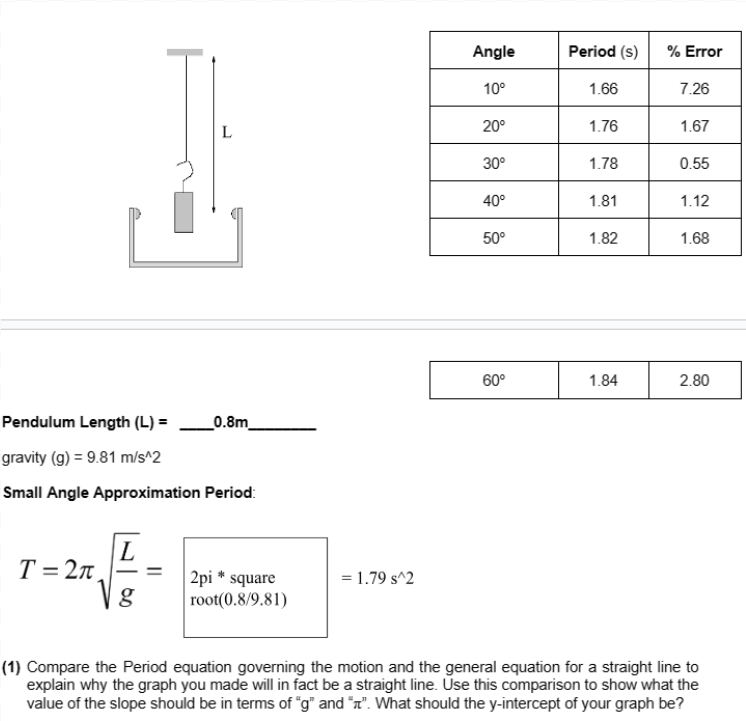Angle Period (s) % Error 10° 1.66 7.26 20° 1.76 1.67 L 30° 1.78 0.55 40° 1.81 1.12 50° 1.82 1.68 60° 1.84 2.80 Pendulum Length (L) = 0.8m gravity (g) 9.81 m/s^2 Small Angle Approximation Period: L T=2π √g 2pi* square root(0.8/9.81) = 1.79 s^2 (1) Compare the Period equation governing the motion and the general equation for a straight line to explain why the graph you made will in fact be a straight line. Use this comparison to show what the value of the slope should be in terms of "g" and "x". What should the y-intercept of your graph be?
Angle Period (s) % Error 10° 1.66 7.26 20° 1.76 1.67 L 30° 1.78 0.55 40° 1.81 1.12 50° 1.82 1.68 60° 1.84 2.80 Pendulum Length (L) = 0.8m gravity (g) 9.81 m/s^2 Small Angle Approximation Period: L T=2π √g 2pi* square root(0.8/9.81) = 1.79 s^2 (1) Compare the Period equation governing the motion and the general equation for a straight line to explain why the graph you made will in fact be a straight line. Use this comparison to show what the value of the slope should be in terms of "g" and "x". What should the y-intercept of your graph be?
College Physics
10th Edition
ISBN:9781285737027
Author:Raymond A. Serway, Chris Vuille
Publisher:Raymond A. Serway, Chris Vuille
Chapter1: Introduction
Section: Chapter Questions
Problem 48P
Related questions
Question
University Physics 1 - Gravitation & Oscillation
I need help with this problem and an explanation of why its the answer described below:
A Simple Pendulum Lab (Image shown below):
What happens to the percent difference between the actual period and the small angle period as the angle increases? Explain why this matches what we expect.

Transcribed Image Text:Angle
Period (s)
% Error
10°
1.66
7.26
20°
1.76
1.67
L
30°
1.78
0.55
40°
1.81
1.12
50°
1.82
1.68
60°
1.84
2.80
Pendulum Length (L) =
0.8m
gravity (g) 9.81 m/s^2
Small Angle Approximation Period:
L
T=2π
√g
2pi* square
root(0.8/9.81)
= 1.79 s^2
(1) Compare the Period equation governing the motion and the general equation for a straight line to
explain why the graph you made will in fact be a straight line. Use this comparison to show what the
value of the slope should be in terms of "g" and "x". What should the y-intercept of your graph be?
Expert Solution
This question has been solved!
Explore an expertly crafted, step-by-step solution for a thorough understanding of key concepts.
This is a popular solution!
Trending now
This is a popular solution!
Step by step
Solved in 2 steps with 6 images

Recommended textbooks for you

College Physics
Physics
ISBN:
9781285737027
Author:
Raymond A. Serway, Chris Vuille
Publisher:
Cengage Learning

Principles of Physics: A Calculus-Based Text
Physics
ISBN:
9781133104261
Author:
Raymond A. Serway, John W. Jewett
Publisher:
Cengage Learning

Physics for Scientists and Engineers, Technology …
Physics
ISBN:
9781305116399
Author:
Raymond A. Serway, John W. Jewett
Publisher:
Cengage Learning

College Physics
Physics
ISBN:
9781285737027
Author:
Raymond A. Serway, Chris Vuille
Publisher:
Cengage Learning

Principles of Physics: A Calculus-Based Text
Physics
ISBN:
9781133104261
Author:
Raymond A. Serway, John W. Jewett
Publisher:
Cengage Learning

Physics for Scientists and Engineers, Technology …
Physics
ISBN:
9781305116399
Author:
Raymond A. Serway, John W. Jewett
Publisher:
Cengage Learning

College Physics
Physics
ISBN:
9781305952300
Author:
Raymond A. Serway, Chris Vuille
Publisher:
Cengage Learning

An Introduction to Physical Science
Physics
ISBN:
9781305079137
Author:
James Shipman, Jerry D. Wilson, Charles A. Higgins, Omar Torres
Publisher:
Cengage Learning

Physics for Scientists and Engineers: Foundations…
Physics
ISBN:
9781133939146
Author:
Katz, Debora M.
Publisher:
Cengage Learning